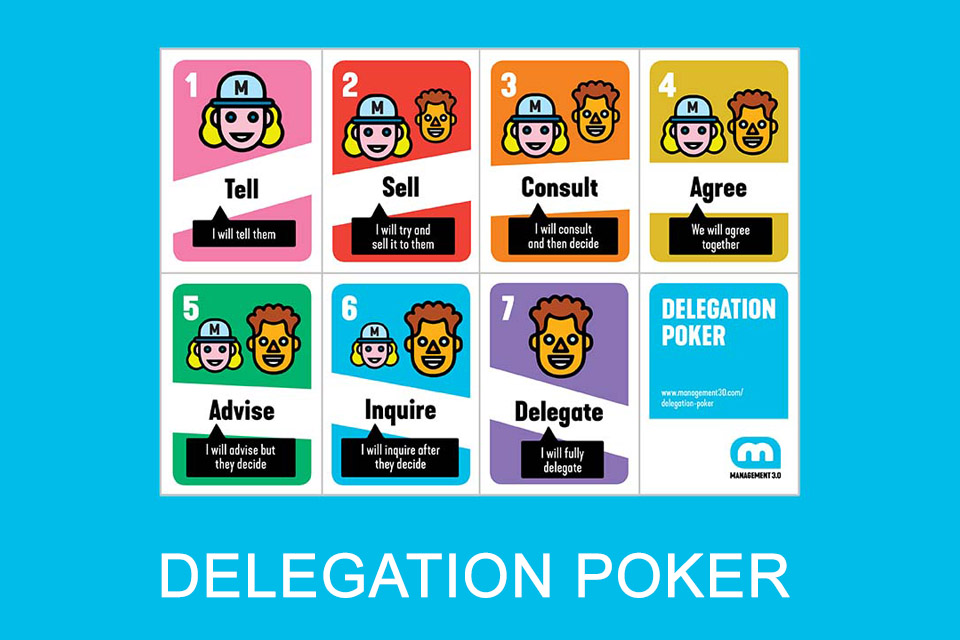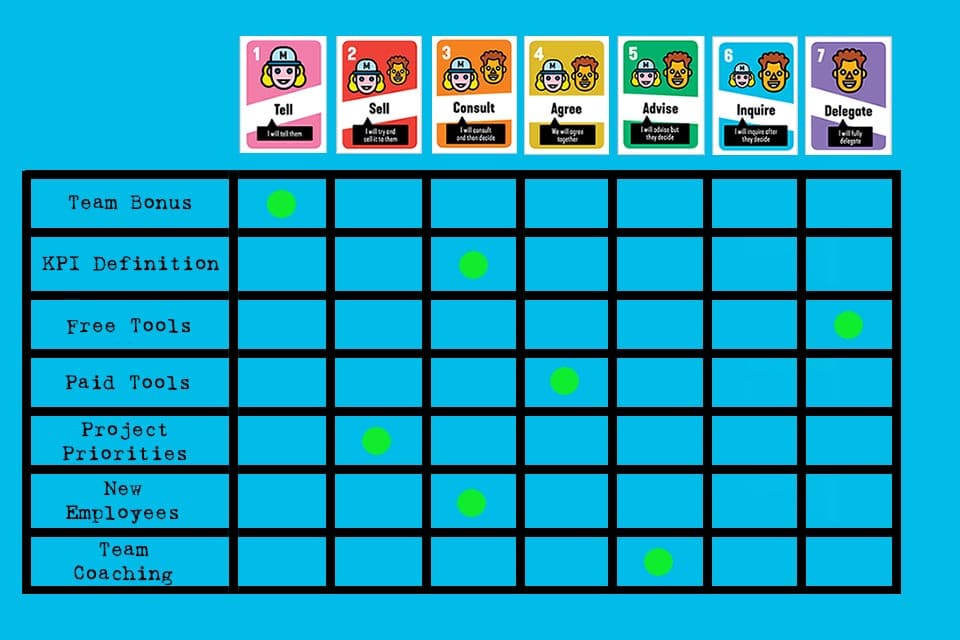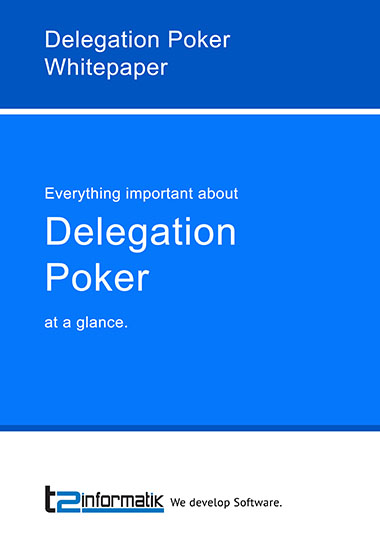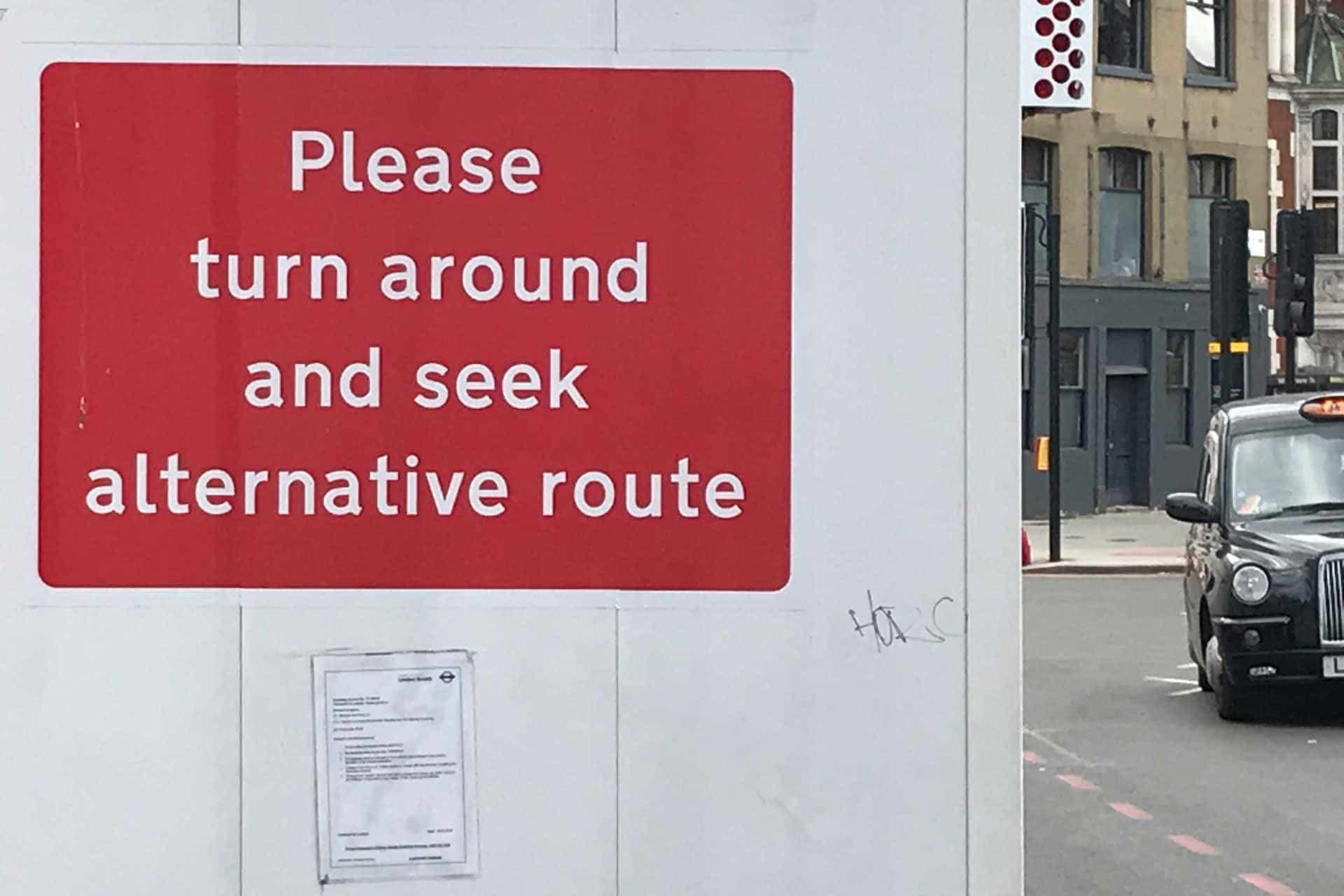What is Delegation Poker?
Table of contents: Definition – Means of Self-Organisation – Learning Objectives – Management 3.0 – Levels of Delegation – Procedure – Delegation Board – Examples – Advantages – Tips – Download – Notes
Smartpedia: Delegation Poker is a game for teams, which deals with the delegation of decisions and responsibility in order to derive rules of action for cooperation.
Delegation Poker Definition
Self-organised work is considered an essential element of agile leadership. It is based on the principle of delegation, according to which competencies and responsibility are transferred to employees. Delegation Poker is a technique for teams that playfully addresses this delegation in order to derive rules of action for cooperation and decision-making.
In Delegation Poker, each participant is given 7 identical cards, each card having a specific meaning. Card 1, for example, stands for “Tell”; the leader announces a decision but does not give reasons for it. Card 7 stands for “Delegate”, i.e. the team may decide on a situation completely autonomously without having to agree the decision with a superior.
After a situation to be assessed has been named, each player chooses the card with the number which, in his view, corresponds to the degree of delegation. In order to avoid mutual interference, the cards are placed face down on the table with the number facing down and are revealed together on command. A discussion then begins on the degree of delegation, with the aim of arriving at a common assessment.
The Delegation as a Means of Self-Organisation
The Latin term delegare means send, entrust or transfer. In the course of the theory of organisation, delegation stands for the transfer of authority and responsibility to task holders. Along with standardisation and participation, delegation is considered a form of the so-called vertical division of labour, which provides for specialisation according to the degree of decision-making authority. This decision-making power, which in traditionally managed companies is exercised by managers, directors, board members, owners or supervisory boards, should in agile organisations be vested in the employees. However, it is often unclear how far decision-making powers can, should or may reach.
Delegation Poker offers the possibility to playfully deal with the different levels of delegation of decisions in a team, in a protected room. The aim is to clarify together who has which responsibilities and powers in which situations, in order to subsequently derive rules of action for the team and for cooperation.
The Learning Objectives at Delegation Poker
Delegation Poker is about recognising three things:
- Delegation is not a binary either-or decision, i.e. there are different levels between a simple announcement of a decision by a manager to the full delegation of authority and responsibility to a team.
- Delegation is a step-by-step process. Self-organisation does not come about by order or at the push of a button, it grows step by step, through shared understanding, experience and feedback.
- Delegation is situation and context dependent. It is a matter of discussing who is allowed to do what and what information or competences are necessary for this.
Management 3.0 and Delegation Poker
Manage the system and not the employees and define leadership as a task for each employee and not as a task for managers – this attitude or mindset is propagated by Management 3.0. To promote self-organisation, self-responsibility and self-development of employees in organisations, Management 3.0 offers a collection of games, tools and practices.
Delegation Poker is one of these games. It was developed by Jurgen Appelo, who in his book “Management 3.0: Leading Agile Developers, Developing Agile Leaders”¹ deals with the changing role of management in agile companies, self-organised teams and the delegation of responsibilities. And Delegation Poker addresses the differentiated delegation of responsibilities.
7 Levels of Delegation
Delegation Poker distinguishes 7 levels of delegation. They are formulated from a manager’s perspective and each level is reflected on a map in the game:
1. Tell: “I will tell them.”
The manager makes a decision and announces it. Usually without justification or discussion.
2. Sell: “I will try and sell it to them.”
The manager makes a decision, gives reasons for the decision and tries to convince the team.
3. Consult: “I will consult and then decide.”
The manager asks for the team’s opinion before making a decision.
4. Agree: “We will agree together.”
There is a discussion with all parties involved and together they decide by consensus.
5. Advise: “I will advise, but they decide.”
After the team seeks advice from the manager, it makes the decision.
6. Inquire: “I will inquire after they decide.”
The team makes the decision and the manager inquires about the outcome and the reasons.
7. Delegate: “I will fully delegate.”
The manager leaves the autonomous decision to the team.
A closer look reveals a symmetrical structure of the 7 levels of delegation: In the first three levels the manager decides and the participation of the team varies. Levels 5, 6 and 7 reflect this and the team makes the decisions, with the manager participating differently. Level 4 is in the middle: here the manager and the team jointly make a decision by consensus.
The Procedure in Delegation Poker
Delegation Poker can be divided into three phases:
- Game preparation
- Game execution
- Documentation of the results
The preparation of the game consists of two steps:
- Each player / team member thinks about scenarios (the so-called Delegation Poker Stories) in which decisions have to be made, e.g. in case of unclear responsibilities, expectations, decision competences etc. (see Examples of Scenarios).
- Each player / team member receives 7 cards according to the level of delegation, i.e. each participant has cards numbered from 1 to 7.
The game includes the following steps:
- A participant chooses a scenario, describes it briefly or reads it out loud – if it was written down in the game preparation.
- Each participant considers which delegation level he sees for the scenario, chooses the appropriate card, puts it face down (with the number down) on the table and turns it over on command.
- Each participant receives points according to the value of his card, except for the players with the “highest minority” or “lowest minority” (see Tips).
- The players with the highest and lowest choice justify their choice.
- Since the aim of the game is to reach decisions by consensus, the scenario is played again in the hope of achieving a unanimous result. (see also here Tips).
Last but not least the documentation of the results follows. The documentation is very important, because it helps to avoid possible misunderstandings. Here, the use of a so-called Delegation Board, which can be quickly displayed on a flipchart, a whiteboard or a simple wall surface and should be clearly visible to every team member, is a good idea.
The Delegation Board
It is important for organisations to know who should and may make decisions in which situation. The Delegation Board is one way of visualising or documenting the decisions taken by consensus. The structure as a matrix or table is very simple: there is one column per delegation level, i.e. 7 columns in total. Scenarios, task areas or situations are named in the rows. And in the fields the agreed level of delegation or decision-making competence is visualised.
- It helps to understand the delegation as a step-by-step learning process.
- It offers the opportunity to reflect, for example, on what has proved successful, what could be improved, what could move to the right or should move to the left.
- It enables a look into the future and a discussion about the competences needed in the team in the future on the way to self-organisation.
The Delegation Board therefore offers more than just documentation, it is also a simple and efficient means of communication.
Examples of Delegation Poker Stories
In theory, any situation where a decision has to be made is suitable as a scenario for delegation poker. But: is it worthwhile, for example, to discuss in a team whether an employee may position his desk differently in an office? Probably many situations can be solved without having to discuss them extensively as Delegation Poker Stories.
Practice shows that even if responsibilities, expectations and decision-making powers are unclear, precise scenario descriptions are very useful. Example: the procurement of software for a team. It is obvious that a team at least wants to participate in the decision for a specific software, ideally even to make it itself. But where are the limits? What influence do budgets or costs have on a possible decision-making authority? What is the situation with Open Source tools? It is therefore worthwhile to grasp possible boundary conditions in the stories and take them into account in the decision-making delegation.
If organisations pursue the goal of self-organisation of teams and employees, there are many scenarios and possible Delegation Poker Stories. Here are a few examples with regard to the employment and payment of employees:
- Employee recruitment: Who defines a need, who determines possible skills and experience, who participates in selection interviews and who makes the recruitment decision?
- Release of employees: A company tries to reduce costs and has to release employees. Who makes the decision to reduce costs in this way? Who decides on the specific redundancies? Who defines the amount of possible severance payments?
- Employee salary: Who determines the salary of employees? How high should the salary of new employees be? How transparent are salaries in the organisation discussed? Who takes the decision to introduce a salary, to abolish or distribute bonuses?
- Promotion of employees: Who decides on the promotion of employees? Who defines the criteria for promotion and who determines the job description?
Many more examples, questions, scenarios or delegation poker stories are easy to find. Under the Tips you will find some hints for the selection of suitable stories.
Delegation Poker Advantages
Delegation Poker offers a number of advantages:
- It ensures transparency in decision-making processes and provides security through the definition of guidelines for action.
- It promotes the exchange of information on decision-making competences and thus promotes understanding among team members. At the same time, expectations of managers become visible.
- It promotes team cohesion through consensus building and increases motivation within the team.
- It strengthens the responsibility of the team, which not only calls for more decision-making competence, but also learns to take responsibility.
- It is simple, saves time and often also nerves, as the combination of simple rules of the game and targeted moderation (see Tips) ensures a structured process.
- It also supports introverted employees who can have their say in the course of the discussion (unless one consciously tries to avoid discussions by merely playing cards in the middle range of values. In case of doubt, the moderator would be called upon here).
- It increases the employees’ freedom of action and thereby strengthens self-organisation.
- It leads to a reduction in the workload of managers, who from now on have to make fewer decisions. At the same time it can contribute to a reduction in hierarchy.
And last but not least: Delegation Poker is fun!
Tips for Delegation Poker
There are also a number of tips on delegation poker:
- Opinions vary as to how many participants can play each round. As agile teams often have nine or fewer members, this is certainly a manageable size. Theoretically and also practically, the game also works with fewer or significantly more members. A Delegation of Delegation Poker similar to a Scrum of Scrums does not exist.
- It is necessary for the manager to participate in the game, who may have to delegate decision-making powers. Without such participation, it would at best be an exercise that should also end in consensus, but would only be the basis for future discussion rounds.
- Since there are many decision-making situations, participants should focus on those that are unclear or have caused problems in the recent past. It may also be advisable to group similar scenarios, one game focuses on the procurement of software, another on how to deal with feedback in the organisation at a different time.
- It is recommended that the game be accompanied by a moderator. Such a moderator could be an Agile Coach or a Scrum Master. He should explain the rules, pay attention to the timebox and mediate between the participants if necessary.
- The use of a timebox per game round and for the whole game is useful. For example, it could be 5 minutes per round.
- Management 3.0 recommends repeating individual game rounds until a consensus is reached between all players. However, if the participants do not reach an agreement, this can in practice quickly break the timebox or the time frame. Postponing the game to a later round or the organisation of a more comprehensive discussion are sensible alternatives.
- The road from 1 to 7 is long. The moderator’s tasks therefore include not only the actual moderation but also the mediation between the participants. If a superior always chooses 1 and wants to continue to make all decisions independently and without consultation, it becomes difficult to develop the organisation in the direction of self-organisation. If team members continuously choose the 7, in order to make all decisions independently from now on, it also becomes difficult. The aim is to empower the team to self-organisation and self-responsibility through different levels of delegation. This goal must be clear to all participants and it is also important to want to achieve this goal together.
- There are organisations that do not note down any points during the game, because noting down the points distracts from the actual goal.
- Other organisations recommend not to give points to the “highest minority” or the “lowest minority”. The “highest minority” is the card with the highest value in a round of the game, but chosen by only one person. In other words: only one participant chooses 7 (or 6 if nobody else chooses 7, etc.) The same applies to the “lowest minority”: a single player chooses the 1.
- In general, excluding staff from the discussion is not recommended. It makes no sense at all to exclude the player with the “lowest minority” from the discussion, because in most cases it is likely to be the manager who does not want to give up decision-making authority. But he or she is certainly essential to the process of self-responsibility of teams.
- The moderator should pay attention to relatively balanced language shares of the participants. A little sensitivity is required here.
- The more concrete a Delegation Poker Story is, the better it can be discussed. The trick is to formulate it in such a way that the general conditions are clear and any preconditions and post-conditions are known. In a way, they are similar to so-called Use Case Specifications.
- There are organisations that use a so-called competence matrix as a starting point for a delegation poker. The competence matrix describes which employee does what and which skills this person has.
- Self-organisation is a process. The intermediate steps, results and goals can be visualised well on the Delegation Board, for example by adding dates, by additional Post Its with supplementary information or by highlighting target fields.
Delegation Poker is easy to understand and relatively simple to use. It is fun. The advantages are manifold. And the insights are important. But: self-organisation is not a wishful thinking. But if one understands self-organisation as a process, takes the time to develop it, and reflects on the present and future, one has a good chance of mastering this process. And Delegation Poker is a very useful tool for this.
Decision-making competence also means that individual team members are able to make decisions independently – without consulting the team – even if these have an impact on other team members or the entire team.
Notes:
On YouTube there are various videos on the subject: How to play Delegation Poker or How to Delegate Better with the 7 Delegation Levels
The cards for the game can be downloaded free of charge in various languages or ordered printed with your logo, for example.
In its layout Delegation Poker is similar to Planning Poker.
Here you can find some additional information from the t2informatik Blog:
If you like the article or would like to discuss it, please feel free to share it in your network. And if you have any comments, please do not hesitate to send us a message.





